
Hydrus is a small constellation in the deep southern sky. It was one of twelve constellations created by Petrus Plancius from the observations of Pieter Dirkszoon Keyser and Frederick de Houtman and it first appeared on a 35-cm (14 in) diameter celestial globe published in late 1597 in Amsterdam by Plancius and Jodocus Hondius. The first depiction of this constellation in a celestial atlas was in Johann Bayer's Uranometria of 1603. The French explorer and astronomer Nicolas Louis de Lacaille charted the brighter stars and gave their Bayer designations in 1756. Its name means "male water snake", as opposed to Hydra, a much larger constellation that represents a female water snake. It remains below the horizon for most Northern Hemisphere observers.

Triangulum Australe is a small constellation in the far Southern Celestial Hemisphere. Its name is Latin for "the southern triangle", which distinguishes it from Triangulum in the northern sky and is derived from the acute, almost equilateral pattern of its three brightest stars. It was first depicted on a celestial globe as Triangulus Antarcticus by Petrus Plancius in 1589, and later with more accuracy and its current name by Johann Bayer in his 1603 Uranometria. The French explorer and astronomer Nicolas Louis de Lacaille charted and gave the brighter stars their Bayer designations in 1756.
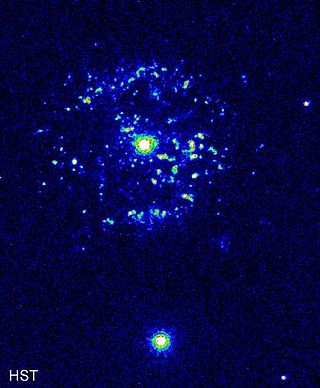
T Pyxidis is a recurrent nova and nova remnant in the constellation Pyxis. It is a binary star system and its distance is estimated at about 4,783 parsecs from Earth. It contains a Sun-like star and a white dwarf. Because of their close proximity and the larger mass of the white dwarf, the latter draws matter from the larger, less massive star. The influx of matter on the white dwarf's surface causes periodic thermonuclear explosions to occur.
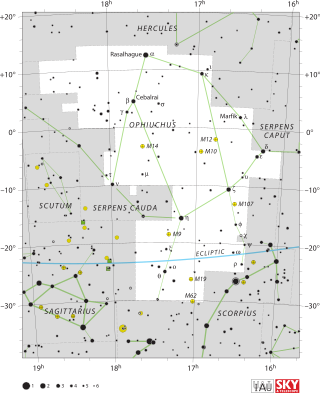
RS Ophiuchi is a recurrent nova system approximately 5,000 light-years away in the constellation Ophiuchus. In its quiet phase it has an apparent magnitude of about 12.5. It has been observed to erupt in 1898, 1933, 1958, 1967, 1985, 2006 and 2021 and reached about magnitude 5 on average. A further two eruptions, in 1907 and 1945, have been inferred from archival data. The recurrent nova is produced by a white dwarf star and a red giant in a binary system. About every 15 years, enough material from the red giant builds up on the surface of the white dwarf to produce a thermonuclear explosion. The white dwarf orbits close to the red giant, with an accretion disc concentrating the overflowing atmosphere of the red giant onto the white dwarf.
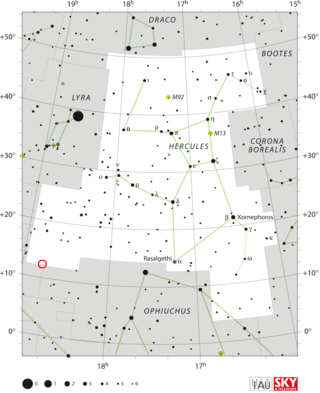
V838 Herculis, also known as Nova Herculis 1991, was a nova which occurred in the constellation Hercules in 1991. It was discovered by George Alcock of Yaxley, Cambridgeshire, England at 4:35 UT on the morning of 25 March 1991. He found it with 10×50 binoculars, and on that morning its apparent visual magnitude was 5. Palomar Sky Survey plates showed that before the outburst, the star was at photographic magnitude 20.6 and 18.25.

A U Geminorum-type variable star, or dwarf nova is one of several types of cataclysmic variable star, consisting of a close binary star system in which one of the components is a white dwarf that accretes matter from its companion. Dwarf novae are dimmer and repeat more frequently than "classical" novae.
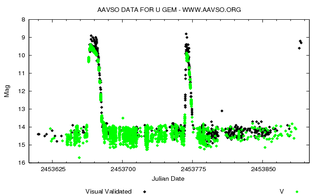
U Geminorum, in the constellation Gemini, is an archetypal example of a dwarf nova. The binary star system consists of a white dwarf closely orbiting a red dwarf. Every few months it undergoes an outburst that greatly increases its brightness. The dwarf nova class of variable stars are often referred to as U Geminorum variables after this star.

WZ Sagittae is a cataclysmic dwarf nova star system in the constellation Sagitta. It consists of a white dwarf primary being orbited by a low mass companion. The white dwarf is about 0.85 solar masses while the companion is only 0.08 solar masses. This implies that the companion is a spectral class L2 star, although this has yet to be confirmed. The distance to this system has been determined by parallax, yielding a distance of 45.1 parsecs.

RX Andromedae is a variable star in the constellation of Andromeda. Although it is classified as a dwarf nova of the Z Camelopardalis (UGZ) type, it has shown low-luminosity periods typical of VY Sculptoris stars. However, for most of the time it varies from an apparent visual magnitude of 15.1 at minimum brightness to a magnitude of 10.2 at maximum brightness, with a period of approximately 13 days.
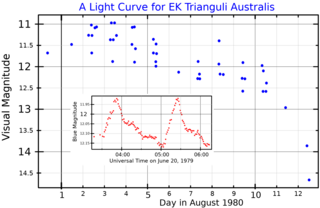
EK Trianguli Australis is a star in the constellation Triangulum Australe. It is a dwarf nova of the SU Ursae Majoris type that officially classified as such in 1980, after the characteristic eruptions of a short eruption and a supereruption were observed in May 1978 and June 1979 respectively. These systems are characterised by frequent eruptions and less frequent supereruptions. The former are smooth, while the latter exhibit short "superhumps" of heightened activity. The distance of the system has been assumed at 180 parsecs from the Solar System, for the donor star. Spectroscopic analysis and calculation gave an estimate of 125 parsecs.

SX Leonis Minoris is a dwarf nova of the SU Ursae Majoris type that was first discovered as a 16th magnitude blue star in 1957, before its identity was confirmed as a dwarf nova in 1994. The system consists of a white dwarf and a donor star which orbit around a common centre of gravity every 97 minutes. The white dwarf sucks matter from the other star via its Roche lobe onto an accretion disc which is heated to between 6000 and 10000 K and periodically erupts every 34 to 64 days, reaching magnitude 13.4 in these outbursts and remaining at magnitude 16.8 when quiet. These outbursts can be split into frequent eruptions and less frequent supereruptions. The former are smooth, while the latter exhibit short "superhumps" of heightened activity and last 2.6% longer.

RR Telescopii is a symbiotic nova in the southern constellation Telescopium. It was recorded on photographic survey plates as a faint variable star between photographic magnitude (mpg) 9 to 16.6 from 1889 to 1944. In late 1944 the star began to brighten, increasing by about 7 magnitudes, from mpg ≈ 14 to brighter than 8. Brightening continued with a diminished rate of increase after early 1945, but the overall outburst was not noted until the star was seen at about 6.0, the threshold of naked eye brightness, in July 1948. At that time it was given the designation Nova Telescopii 1948. Since mid-1949 it has declined in brightness slowly, albeit accompanied by some remarkable changes in its spectrum, and as of August 2013 it had faded to visual magnitude around 12.

TV Corvi, also known as Tombaugh's Star, is a dwarf nova of the SU Ursae Majoris type in the constellation Corvus that was first discovered by accident as a mysterious 12th magnitude star on a plate by Clyde Tombaugh while looking for remote planets on May 25, 1932, before its identity was confirmed as a dwarf nova by David Levy in 1990.

SU Ursae Majoris, or SU UMa, is a close binary star in the northern circumpolar constellation of Ursa Major. It is a periodic cataclysmic variable that varies in magnitude from a peak of 10.8 down to a base of 14.96. The distance to this system, as determined from its annual parallax shift of 4.53 mas, is 719 light-years. It is moving further from the Earth with a heliocentric radial velocity of +27 km/s.
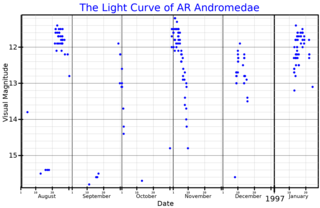
AR Andromedae is a dwarf nova of the SS Cygni type in the constellation Andromeda. Its typical apparent visual magnitude is 17.6, but increases up to 11.0 magnitude during outbursts. The outbursts occur approximately every 23 days.

V630 Sagittarii was a nova visible to the naked eye in 1936. It was discovered on 3 October 1936 by Shigeki Okabayashi of Kobe, Japan when it had an apparent magnitude of 4.5.
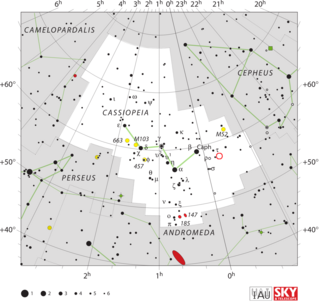
V705 Cassiopeiae, also known as Nova Cassiopeiae 1993 was a nova which erupted in the constellation Cassiopeia during 1993. The nova was discovered at 11:17 UT on 7 December 1993 by amateur astronomer Kazuyoshi Kanatsu of Matsue, Japan, who photographed it using a 35mm camera with a 55mm f/2.8 lens. Asteroid 6976 Kanatsu was named after him in honor of this discovery. At the time of its discovery the nova had a photographic magnitude of 6.5. Around 18 December 1993 it flared briefly to magnitude 5.3, and then it returned rapidly to magnitude 6.5. It underwent a series of smaller flares until mid February 1993, after which it began a precipitous decline in brightness.

BZ Ursae Majoris is a dwarf nova star system in the northern circumpolar constellation of Ursa Major. It consists of a white dwarf primary in a close orbit with a red dwarf. The latter star is donating mass, which is accumulating in an accretion disk orbiting the white dwarf. The system is located at a distance of approximately 505 light years from the Sun based on parallax measurements.

SW Ursae Majoris is a cataclysmic binary star system in the northern circumpolar constellation of Ursa Major, abbreviated SW UMa. During quiescence it has an apparent visual magnitude of 16.5–17, which is too faint to be visible to the naked eye. Based on parallax measurements, it is located at a distance of approximately 526 light years from the Sun.

CR Boötis is an interacting binary system in the northern constellation of Boötes, abbreviated CR Boo. It is one of the best-known AM Canum Venaticorum stars. The system varies widely in brightness, ranging in apparent visual magnitude from 13.6 down to 17.5. The distance to this system is approximately 1,150 light years from the Sun, based on parallax measurements.




















